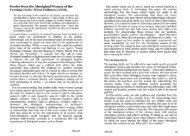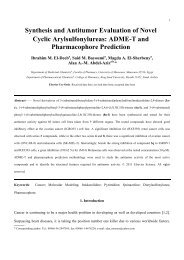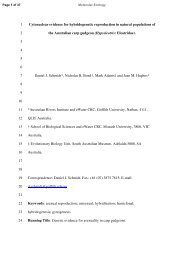Universal Primers for DNA barcoding of all Avian Species - Griffith ...
Universal Primers for DNA barcoding of all Avian Species - Griffith ...
Universal Primers for DNA barcoding of all Avian Species - Griffith ...
Create successful ePaper yourself
Turn your PDF publications into a flip-book with our unique Google optimized e-Paper software.
Two sets <strong>of</strong> internal primers (Table 1) were designed to span the 648bp COI region <strong>for</strong><br />
historical samples considered to have low quality <strong>DNA</strong>. The first primer set contained three<br />
primer pairs resulting in three overlapping fragments (average length ~310bp; Fig. 1). The<br />
second primer set contained five primer pairs resulting in five shorter overlapping fragments<br />
(average length ~ 190bp; Fig 1) to span the same 648bp region. Each internal primer<br />
contained a randomly generated 18bp tag attached to its 5’ end in order to improve the<br />
sequencing <strong>of</strong> the resulting PCR products. Forward internal primers <strong>all</strong> contained an identical<br />
Ftag sequence and similarly <strong>all</strong> reverse internal primers contained an identical Rtag sequence.<br />
Internal primer pairs were tested on a range <strong>of</strong> modern samples represented from 15 avian<br />
orders prior to being used to amplify <strong>DNA</strong> from historical samples.<br />
Three primers, one <strong>for</strong>ward and two reverse were designed to amplify the entire 648bp COI<br />
region as a single fragment to be used <strong>for</strong> modern specimens. The <strong>for</strong>ward primer, AWCF1<br />
was also used as part <strong>of</strong> the primer set <strong>for</strong> historical samples. Primer pairs intended <strong>for</strong><br />
modern specimens did not contain the 18bp tags. All primer sequences and their expected<br />
fragment lengths are shown in Table 1.<br />
<strong>DNA</strong> Extraction from historical and modern samples<br />
Historical specimens in the <strong>for</strong>m <strong>of</strong> dried skins used <strong>for</strong> this study were obtained from<br />
Canterbury Museum (Christchurch, New Zealand). Until 1970 <strong>all</strong> specimens were preserved<br />
with arsenical soap. After this date the preservative used was changed to borax. Both methods<br />
are commonly used in museums worldwide. Preparation did not involve any special<br />
preservation on the legs and toe pads however. These were <strong>all</strong>owed to dry out natur<strong>all</strong>y (P<br />
Sc<strong>of</strong>ield 2009, pers. comm. 6 April,). All samples were collected from the foot and toe region<br />
<strong>of</strong> the specimens.<br />
Between 5 and 64mg <strong>of</strong> tissue was used per extraction and <strong>all</strong> tissue was macerated with a<br />
sterile scalpel blade prior to extraction. <strong>DNA</strong> isolation from dried skins was per<strong>for</strong>med using<br />
proteinase K/DTT/SDS digestion followed by a DNeasy tissue extraction kit <strong>for</strong> the post-lysis<br />
steps according to the manufacturer’s instructions (Qiagen). Negative controls were included<br />
<strong>for</strong> each set <strong>of</strong> extractions. No more than five samples were extracted per set. All pre-PCR<br />
steps were carried out in a separate laboratory solely dedicated to ancient <strong>DNA</strong> work. <strong>DNA</strong><br />
from modern samples (fresh tissue) was extracted in a different laboratory using a standard<br />
5





